Kriti Aggarwal
RED QUEEN: Safeguarding Large Language Models against Concealed Multi-Turn Jailbreaking
Sep 26, 2024



Abstract:The rapid progress of Large Language Models (LLMs) has opened up new opportunities across various domains and applications; yet it also presents challenges related to potential misuse. To mitigate such risks, red teaming has been employed as a proactive security measure to probe language models for harmful outputs via jailbreak attacks. However, current jailbreak attack approaches are single-turn with explicit malicious queries that do not fully capture the complexity of real-world interactions. In reality, users can engage in multi-turn interactions with LLM-based chat assistants, allowing them to conceal their true intentions in a more covert manner. To bridge this gap, we, first, propose a new jailbreak approach, RED QUEEN ATTACK. This method constructs a multi-turn scenario, concealing the malicious intent under the guise of preventing harm. We craft 40 scenarios that vary in turns and select 14 harmful categories to generate 56k multi-turn attack data points. We conduct comprehensive experiments on the RED QUEEN ATTACK with four representative LLM families of different sizes. Our experiments reveal that all LLMs are vulnerable to RED QUEEN ATTACK, reaching 87.62% attack success rate on GPT-4o and 75.4% on Llama3-70B. Further analysis reveals that larger models are more susceptible to the RED QUEEN ATTACK, with multi-turn structures and concealment strategies contributing to its success. To prioritize safety, we introduce a straightforward mitigation strategy called RED QUEEN GUARD, which aligns LLMs to effectively counter adversarial attacks. This approach reduces the attack success rate to below 1% while maintaining the model's performance across standard benchmarks. Full implementation and dataset are publicly accessible at https://github.com/kriti-hippo/red_queen.
sPhinX: Sample Efficient Multilingual Instruction Fine-Tuning Through N-shot Guided Prompting
Jul 16, 2024Abstract:Despite the remarkable success of LLMs in English, there is a significant gap in performance in non-English languages. In order to address this, we introduce a novel recipe for creating a multilingual synthetic instruction tuning dataset, sPhinX, which is created by selectively translating instruction response pairs from English into 50 languages. We test the effectiveness of sPhinX by using it to fine-tune two state-of-the-art models, Phi-3-small and Mistral-7B and then evaluating them across a comprehensive suite of multilingual benchmarks that test reasoning, question answering, and reading comprehension. Our results show that Phi-3-small and Mistral-7B fine-tuned with sPhinX perform better on an average by 4.2%pt and 5%pt respectively as compared to the baselines. We also devise a strategy to incorporate N-shot examples in each fine-tuning sample which further boosts the performance of these models by 3%pt and 10%pt respectively. Additionally, sPhinX also outperforms other multilingual instruction tuning datasets on the same benchmarks along with being sample efficient and diverse, thereby reducing dataset creation costs. Additionally, instruction tuning with sPhinX does not lead to regression on most standard LLM benchmarks.
Polaris: A Safety-focused LLM Constellation Architecture for Healthcare
Mar 20, 2024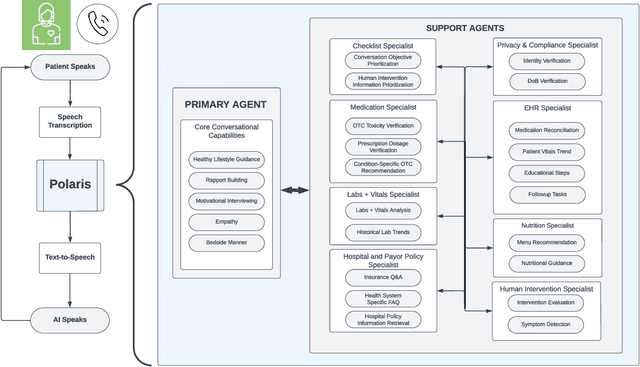
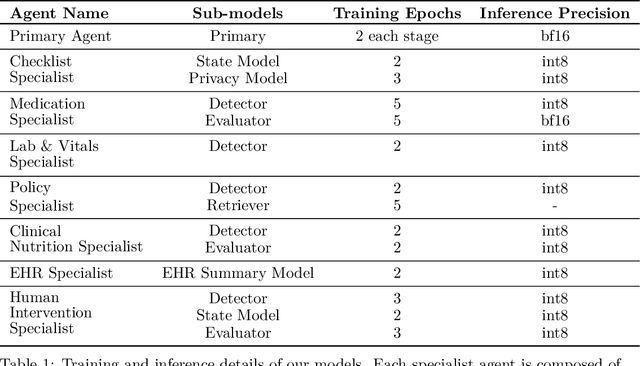
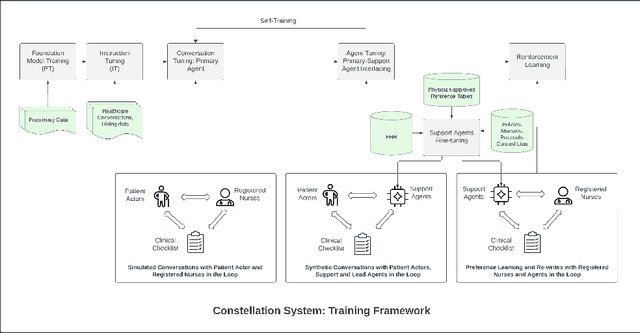
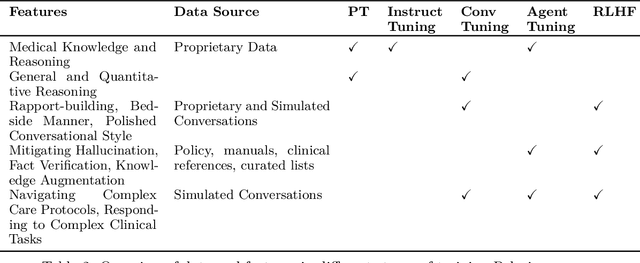
Abstract:We develop Polaris, the first safety-focused LLM constellation for real-time patient-AI healthcare conversations. Unlike prior LLM works in healthcare focusing on tasks like question answering, our work specifically focuses on long multi-turn voice conversations. Our one-trillion parameter constellation system is composed of several multibillion parameter LLMs as co-operative agents: a stateful primary agent that focuses on driving an engaging conversation and several specialist support agents focused on healthcare tasks performed by nurses to increase safety and reduce hallucinations. We develop a sophisticated training protocol for iterative co-training of the agents that optimize for diverse objectives. We train our models on proprietary data, clinical care plans, healthcare regulatory documents, medical manuals, and other medical reasoning documents. We align our models to speak like medical professionals, using organic healthcare conversations and simulated ones between patient actors and experienced nurses. This allows our system to express unique capabilities such as rapport building, trust building, empathy and bedside manner. Finally, we present the first comprehensive clinician evaluation of an LLM system for healthcare. We recruited over 1100 U.S. licensed nurses and over 130 U.S. licensed physicians to perform end-to-end conversational evaluations of our system by posing as patients and rating the system on several measures. We demonstrate Polaris performs on par with human nurses on aggregate across dimensions such as medical safety, clinical readiness, conversational quality, and bedside manner. Additionally, we conduct a challenging task-based evaluation of the individual specialist support agents, where we demonstrate our LLM agents significantly outperform a much larger general-purpose LLM (GPT-4) as well as from its own medium-size class (LLaMA-2 70B).
ODIN: A Single Model for 2D and 3D Perception
Jan 04, 2024Abstract:State-of-the-art models on contemporary 3D perception benchmarks like ScanNet consume and label dataset-provided 3D point clouds, obtained through post processing of sensed multiview RGB-D images. They are typically trained in-domain, forego large-scale 2D pre-training and outperform alternatives that featurize the posed RGB-D multiview images instead. The gap in performance between methods that consume posed images versus post-processed 3D point clouds has fueled the belief that 2D and 3D perception require distinct model architectures. In this paper, we challenge this view and propose ODIN (Omni-Dimensional INstance segmentation), a model that can segment and label both 2D RGB images and 3D point clouds, using a transformer architecture that alternates between 2D within-view and 3D cross-view information fusion. Our model differentiates 2D and 3D feature operations through the positional encodings of the tokens involved, which capture pixel coordinates for 2D patch tokens and 3D coordinates for 3D feature tokens. ODIN achieves state-of-the-art performance on ScanNet200, Matterport3D and AI2THOR 3D instance segmentation benchmarks, and competitive performance on ScanNet, S3DIS and COCO. It outperforms all previous works by a wide margin when the sensed 3D point cloud is used in place of the point cloud sampled from 3D mesh. When used as the 3D perception engine in an instructable embodied agent architecture, it sets a new state-of-the-art on the TEACh action-from-dialogue benchmark. Our code and checkpoints can be found at the project website: https://odin-seg.github.io.
Orca 2: Teaching Small Language Models How to Reason
Nov 21, 2023



Abstract:Orca 1 learns from rich signals, such as explanation traces, allowing it to outperform conventional instruction-tuned models on benchmarks like BigBench Hard and AGIEval. In Orca 2, we continue exploring how improved training signals can enhance smaller LMs' reasoning abilities. Research on training small LMs has often relied on imitation learning to replicate the output of more capable models. We contend that excessive emphasis on imitation may restrict the potential of smaller models. We seek to teach small LMs to employ different solution strategies for different tasks, potentially different from the one used by the larger model. For example, while larger models might provide a direct answer to a complex task, smaller models may not have the same capacity. In Orca 2, we teach the model various reasoning techniques (step-by-step, recall then generate, recall-reason-generate, direct answer, etc.). More crucially, we aim to help the model learn to determine the most effective solution strategy for each task. We evaluate Orca 2 using a comprehensive set of 15 diverse benchmarks (corresponding to approximately 100 tasks and over 36,000 unique prompts). Orca 2 significantly surpasses models of similar size and attains performance levels similar or better to those of models 5-10x larger, as assessed on complex tasks that test advanced reasoning abilities in zero-shot settings. make Orca 2 weights publicly available at aka.ms/orca-lm to support research on the development, evaluation, and alignment of smaller LMs
DUBLIN -- Document Understanding By Language-Image Network
May 24, 2023Abstract:Visual document understanding is a complex task that involves analyzing both the text and the visual elements in document images. Existing models often rely on manual feature engineering or domain-specific pipelines, which limit their generalization ability across different document types and languages. In this paper, we propose DUBLIN, which is pretrained on web pages using three novel objectives: Masked Document Content Generation Task, Bounding Box Task, and Rendered Question Answering Task, that leverage both the spatial and semantic information in the document images. Our model achieves competitive or state-of-the-art results on several benchmarks, such as Web-Based Structural Reading Comprehension, Document Visual Question Answering, Key Information Extraction, Diagram Understanding, and Table Question Answering. In particular, we show that DUBLIN is the first pixel-based model to achieve an EM of 77.75 and F1 of 84.25 on the WebSRC dataset. We also show that our model outperforms the current pixel-based SoTA models on DocVQA and AI2D datasets by 2% and 21%, respectively. Also, DUBLIN is the first ever pixel-based model which achieves comparable performance to text-based SoTA methods on XFUND dataset for Semantic Entity Recognition showcasing its multilingual capability. Moreover, we create new baselines for text-based datasets by rendering them as document images to promote research in this direction.
Language Is Not All You Need: Aligning Perception with Language Models
Mar 01, 2023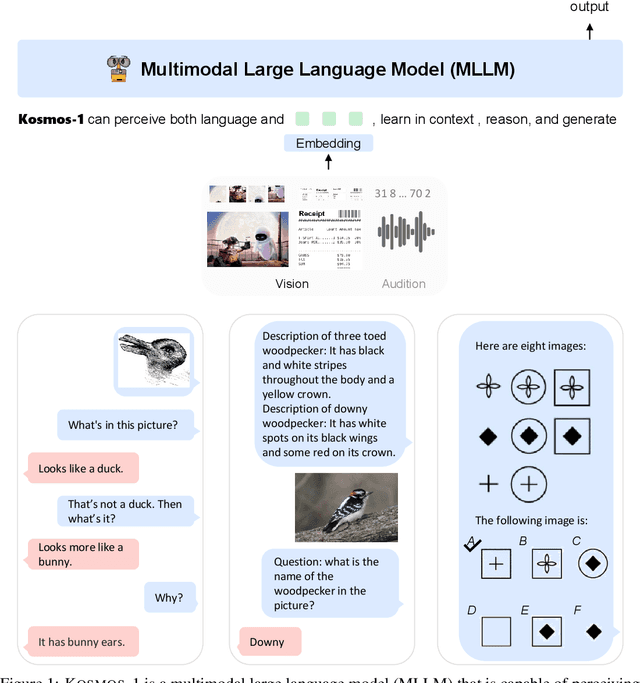
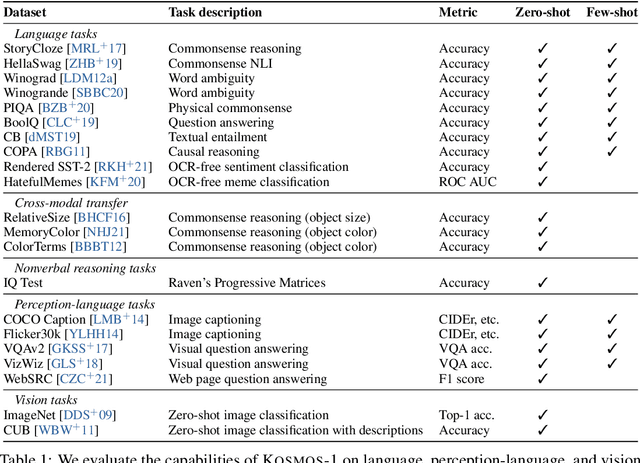
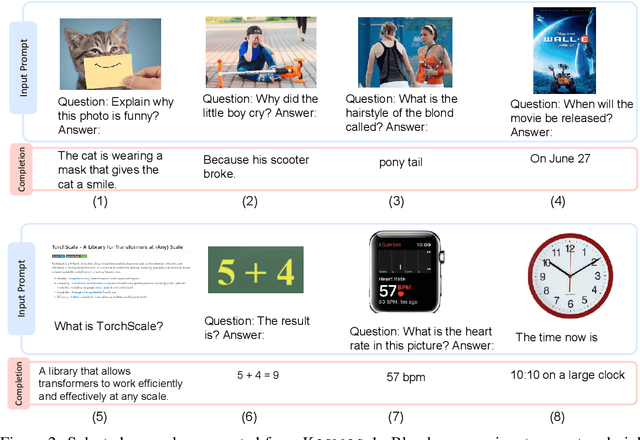
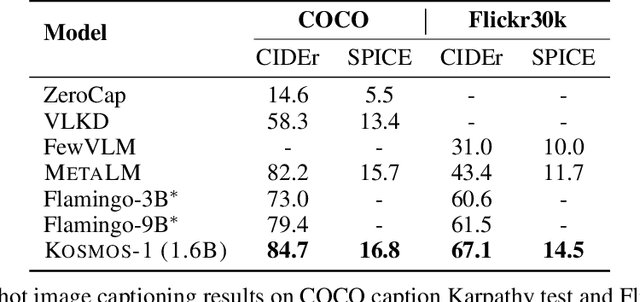
Abstract:A big convergence of language, multimodal perception, action, and world modeling is a key step toward artificial general intelligence. In this work, we introduce Kosmos-1, a Multimodal Large Language Model (MLLM) that can perceive general modalities, learn in context (i.e., few-shot), and follow instructions (i.e., zero-shot). Specifically, we train Kosmos-1 from scratch on web-scale multimodal corpora, including arbitrarily interleaved text and images, image-caption pairs, and text data. We evaluate various settings, including zero-shot, few-shot, and multimodal chain-of-thought prompting, on a wide range of tasks without any gradient updates or finetuning. Experimental results show that Kosmos-1 achieves impressive performance on (i) language understanding, generation, and even OCR-free NLP (directly fed with document images), (ii) perception-language tasks, including multimodal dialogue, image captioning, visual question answering, and (iii) vision tasks, such as image recognition with descriptions (specifying classification via text instructions). We also show that MLLMs can benefit from cross-modal transfer, i.e., transfer knowledge from language to multimodal, and from multimodal to language. In addition, we introduce a dataset of Raven IQ test, which diagnoses the nonverbal reasoning capability of MLLMs.
Image as a Foreign Language: BEiT Pretraining for All Vision and Vision-Language Tasks
Aug 31, 2022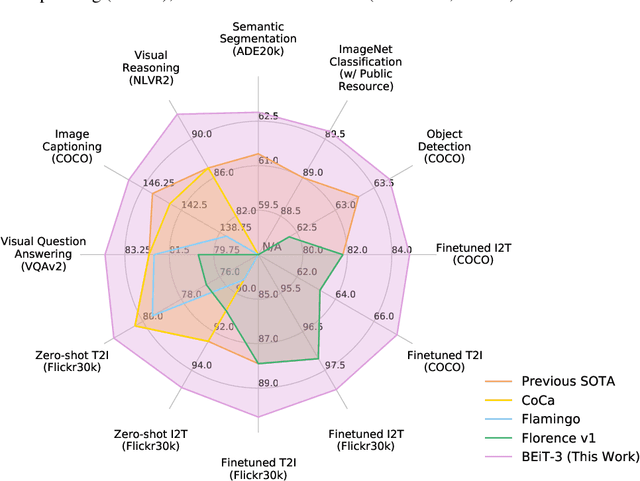
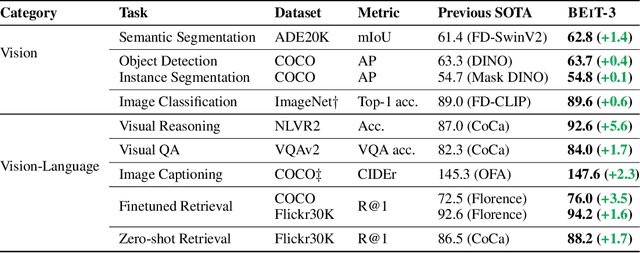
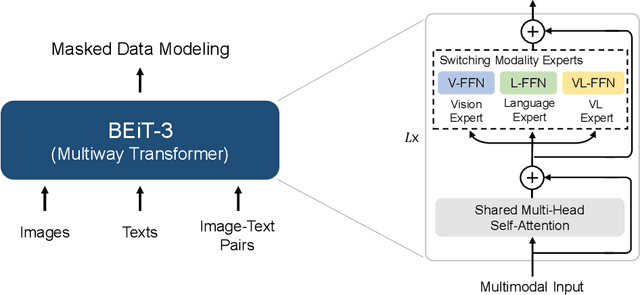

Abstract:A big convergence of language, vision, and multimodal pretraining is emerging. In this work, we introduce a general-purpose multimodal foundation model BEiT-3, which achieves state-of-the-art transfer performance on both vision and vision-language tasks. Specifically, we advance the big convergence from three aspects: backbone architecture, pretraining task, and model scaling up. We introduce Multiway Transformers for general-purpose modeling, where the modular architecture enables both deep fusion and modality-specific encoding. Based on the shared backbone, we perform masked "language" modeling on images (Imglish), texts (English), and image-text pairs ("parallel sentences") in a unified manner. Experimental results show that BEiT-3 obtains state-of-the-art performance on object detection (COCO), semantic segmentation (ADE20K), image classification (ImageNet), visual reasoning (NLVR2), visual question answering (VQAv2), image captioning (COCO), and cross-modal retrieval (Flickr30K, COCO).
 Add to Chrome
Add to Chrome Add to Firefox
Add to Firefox Add to Edge
Add to Edge